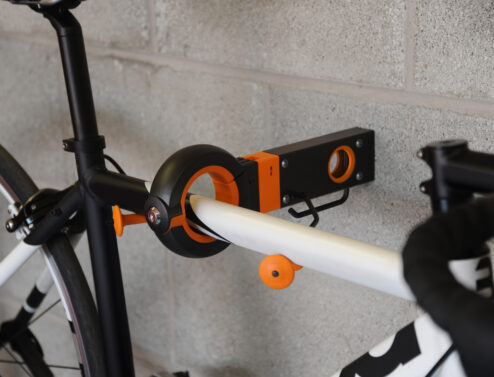Innovating the Future: A Conversation with Renowned Product Designer, Graham Hannath
Innovating the Future: A Conversation with Renowned Product Designer, Graham Hannath
Welcome to PatWorld! Today, we are thrilled to introduce you to Graham Hannath. Graham is a visionary product designer who has been transforming ideas into ground-breaking products for over 25 years.
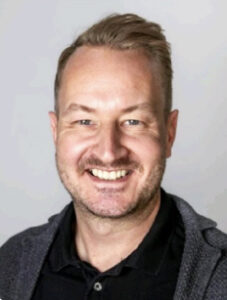
With a rich portfolio of innovative designs, Graham has worked with numerous inventors and companies, turning their concepts into reality. In this exclusive interview, we delve into the mind of Graham Hannath to uncover the secrets behind his creative process, his journey in the world of product design, and his advice for aspiring inventors.
Interview with Graham Hannath
Can you tell us about your journey into product design? What inspired you to pursue this career?
At school, the two things I was interested in were music and art and design. I played guitar at school and in bands, the rest of my time I was making things. My Dad was a teacher at another school and I used to spend weekends in the workshop there making things with him. We made guitars, amplifiers, guitar cases, a canoe, a remote controlled boat… All sorts of things. I chose design and technology as an option at school and made a carrying case for the aforementioned remote controlled boat for my GCSE project. It was this project that gave me my first experience of the buzz you get from seeing and using a product which was developed from your initial idea through to production. Following school, I did a Btech at Jacob Kramer School of art and design in Leeds, starting with Interior Design and then switching to Product Design. Then I completed a Degree at Coventry University before landing my first job designing Loudspeakers and HiFi products at a leading British manufacturer.
Your portfolio showcases a diverse range of products. How do you approach the design process when working with a new idea or invention?
 As a designer, you’re always looking at things from a design/engineering perspective. Whether you’re shopping for homeware, looking around antiques fairs, using your toothbrush or drinking from a water bottle.. You can always spot a good design, or an opportunity to improve an existing one, regardless of the product genre. I’ve designed toothbrushes, telephones, architectural lightning, medical machinery, Hifi products, TV brackets and wine coolers. My philosophy is that, it’s just a product. It doesn’t matter what sort of product, how big it is or what market it comes from. Primarily, as long as you understand the purpose of the product, its main functionality and most importantly, the client’s requirements and expectations of the product, then you can apply your design creativity to it. Of course there will be practical factors to consider, such as Tooling budgets, time scales and commercial viability. All of these can be managed with the client throughout the project whilst retaining freedom and creativity in the design process.
As a designer, you’re always looking at things from a design/engineering perspective. Whether you’re shopping for homeware, looking around antiques fairs, using your toothbrush or drinking from a water bottle.. You can always spot a good design, or an opportunity to improve an existing one, regardless of the product genre. I’ve designed toothbrushes, telephones, architectural lightning, medical machinery, Hifi products, TV brackets and wine coolers. My philosophy is that, it’s just a product. It doesn’t matter what sort of product, how big it is or what market it comes from. Primarily, as long as you understand the purpose of the product, its main functionality and most importantly, the client’s requirements and expectations of the product, then you can apply your design creativity to it. Of course there will be practical factors to consider, such as Tooling budgets, time scales and commercial viability. All of these can be managed with the client throughout the project whilst retaining freedom and creativity in the design process.
What are some of the biggest challenges you face as a product designer, and how do you overcome them?
- Demonstrating the value of investing in good design has always been a challenge. Design isn’t drawing nice pictures or presenting amazing visuals. Particularly with the recent advent of AI, design is in danger of being seen as simply producing visually stunning images rather than working through real problems and producing commercially successful products. The way to overcome this is to be open and honest with your client from day one with regards to expectations, costs, lead times and deliverables.
- Fear of designer’s block! Like any creative profession there’s no secret formula to coming up with good ideas and there’s always an uncertainty as to how a project will develop. At the beginning of any project there’s a trepidation, “what if I can’t think of anything” or “what if they don’t like any of my proposals?” All you can do as a designer is to look at your track record and past successes and trust that you will have THAT spark.
- Remembering you are working for the client. Designers (and most other creatives) have a reputation for being stubborn, self opinionated and difficult to direct. This could be true of some, and may be beneficial to others. However, the client has brought their vision to you to realise, and it’s your job to work with them to make their vision as successful as possible. This may mean working on products you don’t like or going in directions you don’t agree with. Regardless, the end goal is to give the client the best version of their vision possible. And, to assist them in making their product a success.
What advice would you give to inventors and entrepreneurs who are looking to bring their ideas to life through product design?
Don’t be scared! With the right team on board, bringing your ideas to life isn’t as difficult, or as expensive as you may think. Also, due to the processes involved and the rise of low priced rapid prototyping and 3D printing, you can get a pretty good idea of the viability of your product without going too far down the road and with relatively little expenditure. The design process is split into several fairly simple stages – Concept, Development, Detailing, Prototyping, Costing, Detailing for Manufacture, Manufacture. At any of these stages, you can change direction, re-define the brief, re-evaluate budgets, or even bail out completely. The only way to find out is to take that first step.
Featured Projects
Project 1: “Hangman” Bicycle Hanger
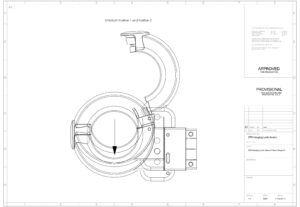

The Hangman bicycle storage and security system was conceived, designed and manufactured from scratch. Some moulded components were sourced from the Far East with the remainder produced in the UK. The finished units were manufactured and assembled in Nottingham.
The unique feature of the design is the weight-triggered clasp which opens when the weight of the bike is removed and closes when the bike is put back in place. The unit supports the bike whilst locking and unlocking. It can be locked with one hand and without having to wrap locks or chains around the bike frame. The mechanism makes storage and locking quick and convenient for use in small or cluttered spaces such as apartments, outbuildings or garages.
Project 2: Tilt and Swivel Plastic Bracket Mechanism
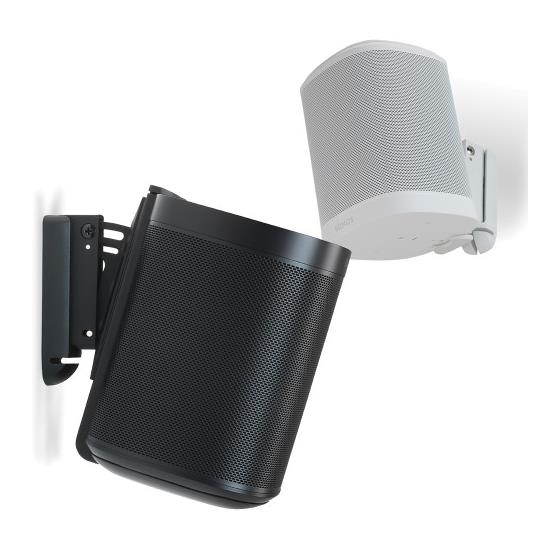 The brief for this project was to design a unique tilt and swivel mechanism which could be used on various wall mounted speaker accessories. The primary use was for Sonos speaker wall brackets. However, the mechanism was used across various products and is still being used to this day due to its low cost, good flexibility and high functionality. The plastic parts are tooled, manufactured and assembled in the Far East using one of our many trusted suppliers. They are then assembled into the various finished products in the UK. This mechanism was Patented in the UK.
The brief for this project was to design a unique tilt and swivel mechanism which could be used on various wall mounted speaker accessories. The primary use was for Sonos speaker wall brackets. However, the mechanism was used across various products and is still being used to this day due to its low cost, good flexibility and high functionality. The plastic parts are tooled, manufactured and assembled in the Far East using one of our many trusted suppliers. They are then assembled into the various finished products in the UK. This mechanism was Patented in the UK.
Project 3: Ice and Water-Free bottle coolers
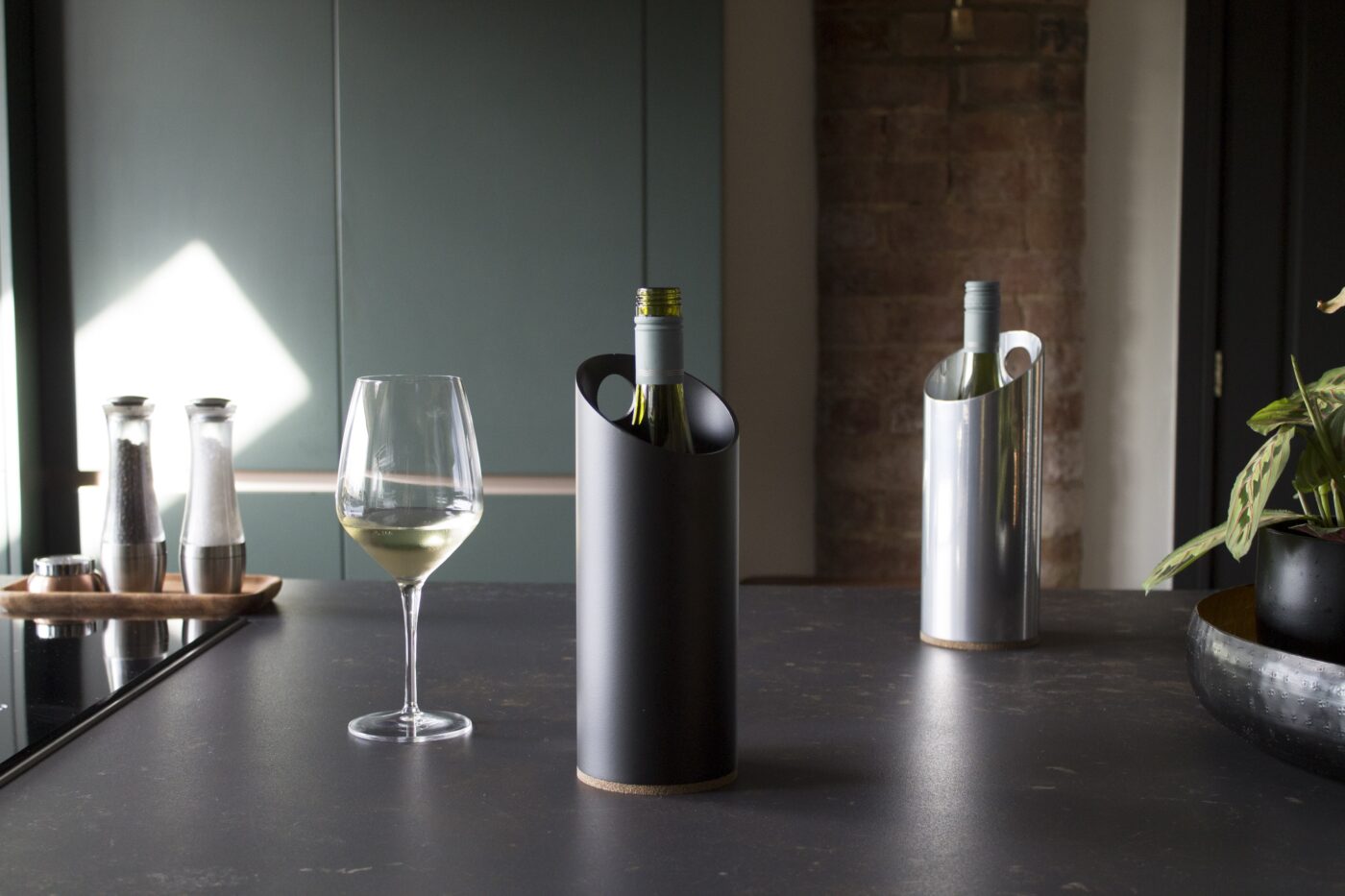 This is a product designed for home or commercial use. The brief was to design a wine cooler which reduced the use of ice, water and associated plastic waste such as ice bags. The design uses extruded aluminium which has unique thermal properties, a reusable ice puck and a recycled cork non-slip base. The designs were tested against alternative methods such as ice buckets with water and double walled flasks and were proven to be more efficient. Additional benefits are the lack of condensation, no drips or spills on your table and increased portability. All aesthetic designs have been registered and the principle is subject to a Pending Patent Application.
This is a product designed for home or commercial use. The brief was to design a wine cooler which reduced the use of ice, water and associated plastic waste such as ice bags. The design uses extruded aluminium which has unique thermal properties, a reusable ice puck and a recycled cork non-slip base. The designs were tested against alternative methods such as ice buckets with water and double walled flasks and were proven to be more efficient. Additional benefits are the lack of condensation, no drips or spills on your table and increased portability. All aesthetic designs have been registered and the principle is subject to a Pending Patent Application.
We hope you enjoyed this insightful conversation with Graham Hannath. His passion and expertise in product design is truly inspiring. If you are an inventor or entrepreneur looking to bring your ideas to life, Graham is the perfect partner to help you navigate the design process and create something extraordinary. Stay tuned for more inspiring stories and interviews here at PatWorld.com!
Ready to start your design journey? Contact Graham Hannath at [email protected] or visit their website at HOME | Grahamhannathdesign for more information.
PatWorld Search Services
At PatWorld, we understand the importance of protecting your innovative ideas. Our comprehensive patent search services are designed to help you determine the patentability of your product, identify potential infringements, and navigate the complex patent landscape. Conducting a patent search is crucial at various stages of product development. Including, during the initial concept phase, before filing a patent application, and when preparing for market launch. Our expert team is here to support you every step of the way. Ensuring that your inventions are safeguarded, and your innovation journey is smooth.
Visit Patent Search | Non-Patent Search | All Technologies (patworld.com) to learn more about our services and how we can assist you.
